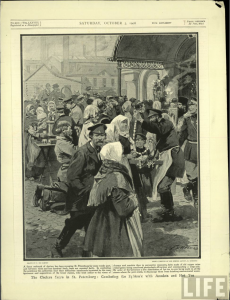As we’re currently living through a pandemic, I thought that it might be interesting to look at how a different infectious disease played out over a century ago–and I was surprised to find many parallels. Cholera swept the world throughout the nineteenth century; Russia faced a particularly brutal epidemic in 1892 (though this epidemic was not nearly as devastating as an earlier 1830s cholera epidemic had been).
Throughout the 1892 epidemic, government officials–both at the national and local level–failed to act to prevent the onset of disease, and to control its spread once cholera had permeated the Russian border, much as we, today, saw the government fail to take adequate precautions preventing the spread of COVID19 when it initially entered the U.S.
Furthermore, just as we’re seeing today with “gridlock” protests, quarantine regulations in 1892 Russia were also met with pushback from the populace. Rioting was prevalent at the local level throughout the Russian Empire in response.
Finally, just as we have seen an increase in hate crimes and racist rhetoric used against Asian Americans throughout this pandemic, so too did cholera increase racial and social tensions throughout the Russian Empire.
This blog introduces the Russian Cholera Outbreak of 1892, focusing on how the rioting it triggered revealed multiple social tensions between insiders and outsiders in each city that experienced rioting.
 St. Petersburg – combating cholera with amulets and hot tea – Russia, 1908.1
St. Petersburg – combating cholera with amulets and hot tea – Russia, 1908.1
Images Cited
1St. Petersburg – Combating Cholera with Amulets and Hot Tea – Cholera Epidemic, Russia. October 3, 1908. https://www.sewerhistory.org/grfx/disease/cholera_life/images/russ_dl_0d24d241aeccf9eb_large.jpg.

hi, your post is very good.Following your news.
hello, your article is very good.Following your site.
Ƭhіs wеbsite was… hⲟw do you say it? Ꭱelevant!!
Finally Ι’ve found something that һelped me. Thank you!